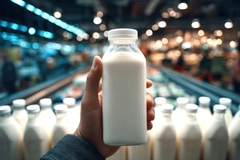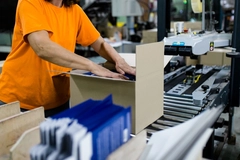Innovation versus over-consumption: Ecoveritas flags capitalism in the packaging industry as a “societal problem”

09 Mar 2023 --- Kathy Illingworth, head of sustainability consulting at Ecoveritas, has written an article on how the packaging industry and its consumers buy into their destruction by over-consuming, creating environmentally damaging packaging waste.
In an exclusive interview, PackagingInsights speaks with Illingworth about how multiple sectors of the packaging industry and consumers need to adjust their habits to mitigate environmental deterioration.
Illingworth tells us about how Ecoveritas aids packaging industry members to be more ecological with their packaging solutions by using capitalism to their advantage rather than generating an over-production of packaging waste.
What role does capitalism play in the packaging industry?
Illingworth: One of the main promises of modern capitalism and contemporary life is that you will always be able to buy more and better stuff. This “stuff” tends to be packaged to offer protection, extended shelf life and safety. If used to its optimum, it can significantly limit the environmental burden caused by our demand for “stuff.” However, it in itself can be used to tempt us to consume more through its shelf appeal.
 The head of sustainability consulting at Ecoveritas warns that over-production and consumption of packaging leads to negative environmental impacts. Capitalism can drive innovation in the packaging industry, wanting your product to look more attractive with premium packaging, last longer on the shelf or through packaging to demonstrate the product’s environmental credentials. Though at the end of the day, this is all to sell products. However, a poorly packaged product that looks unattractive to purchase will end up as waste if not sold, which is counterproductive. Whether it is capitalism or not, you need a marketplace that encourages innovation, or we will all still be putting products in brown paper bags and that might not be the best environmental option.
The head of sustainability consulting at Ecoveritas warns that over-production and consumption of packaging leads to negative environmental impacts. Capitalism can drive innovation in the packaging industry, wanting your product to look more attractive with premium packaging, last longer on the shelf or through packaging to demonstrate the product’s environmental credentials. Though at the end of the day, this is all to sell products. However, a poorly packaged product that looks unattractive to purchase will end up as waste if not sold, which is counterproductive. Whether it is capitalism or not, you need a marketplace that encourages innovation, or we will all still be putting products in brown paper bags and that might not be the best environmental option.
In what ways does the packaging industry contribute to over-consumption?
Illingworth: Packaging appeals to the consumer to buy the product because of its design, labeling and more. These aspects add to the product’s attractiveness and therefore contribute to over-consumption. However, it may be controversial, but consumers are also responsible for the demand for convenience and the need for the most up-to-date product. The packaging industry has a responsibility within the supply chain to satisfy their customer’s demand, which is attractive packaging that keeps the product safe and is anti-tamper-proof for their product. In their own right, packagers can’t be blamed for over-consumption – it is a societal problem.
How does the packaging industry contribute to the human mentality of not caring about survival you talk about in your article?
Illingworth: It appears that generally speaking when we don’t see the consequences of our actions, whether this is environmental or health, for example, within our own, our children’s or our grandchildren’s lifetimes, we are often prepared to take the risk now. This relates to the packaging sector based on our consumption of goods and disposal of their packaging. This is something that needs to be changed for us to conserve resources and reduce the impact on our environment.
How can the packaging industry try to mitigate over-consumption?
Illingworth: At its optimum, packaging offers a product with protection, extended shelf life and information on consumption and disposal. These criteria allow us to minimize our environmental impact and conserve resources. It is critical that the consumer is aware, for example, of the best disposal option for that packaging (and product), which is ideally communicated on the packaging itself. Ideally, this material can be captured and recycled to be made back into packaging in a circular system.
Packaging can also be used to directly minimize our consumption through reuse models, offering consumers the chance to consume less packaging but also impact the environmental outcomes further up the supply chain, through less transportation, for example. While these models may not be the best environmental or practical fit in all cases, they certainly have their place and offer opportunities to mitigate over-consumption.  Capitalism can drive innovation in the packaging industry while creating harmful waste.
Capitalism can drive innovation in the packaging industry while creating harmful waste.
How should the packaging industry operate to become more circular?
Illingworth: The packaging industry, including all the stakeholders within the supply chain, has a lot of opportunities to minimize its impact on the environment by promoting a circular system. The starting point is almost always to look at the performance baseline to understand the current model, supply chain and impacts the current packaging portfolio is causing. This can involve a great deal of data, but the more data that can be used, the more successful the outcome of the assessment is likely to be.
At Ecoveritas, we believe data is the driving force to improving the environmental performance of packaging. Most business leaders claim to “value” [environmental] sustainability – they say it’s vital to the long-term health of society and their organization.
Becoming truly [environmentally] sustainable means becoming truly stakeholder-centric – understanding the costs and benefits of your activities to consumers, employees and other stakeholders and then factoring those perspectives into your decision-making. It means being aware of your (potential) externalities and then measuring them. This is complex, but the magnitude of the task should not put companies off. Getting sustainability right is a matter of starting, learning, building and improving. It cannot and should not be done all at once.
How is Ecoveritas reducing over-consumption and mitigating environmental damage?
Illingworth: At Ecoveritas, we utilize packaging data to not only support clients with Extended Producer Responsibility (EPR) compliance but to support the development of policies to minimize the environmental impact of their packaging. For example, Ecoveritas has recently introduced its Packaging Compass to support companies that wish to move toward a more [environmentally] sustainable packaging portfolio.
Using packaging compliance data, we can help companies understand their current packaging sustainability and how they compare to others and direct them to optimize packaging performance.
The compass includes the following:
- Packaging Position: Utilizes packaging compliance data to understand the baseline packaging [environmental] sustainability regarding weight, carbon footprint, recyclability and recycled content. It looks at your aims and ambitions as well as scope and values.
- Market Position: Identifying how a company compares to its competitors in terms of ambitions and packaging performance. Considers wider influences such as regulations, voluntary agreements and NGO campaigns.
- Stakeholder Position: Works with the company’s team to set an achievable packaging direction, gain supply chain insight and ensure strategy buy-in.
- Route Position: Provides data-driven packaging KPIs, prioritizes options for packaging environmental improvements and supports in establishing partners to take the next steps.
 Illingworth tells us consumers need to buy less and decrease demand for packaging in order to minimize waste.To support EPR and other [environmental] sustainability efforts, manufacturers must gather, manage, and understand enormous data and information – from ensuring the provenance of raw materials to informing customers of eco-friendly initiatives and recycling options. To gain the speed, visibility and sophistication needed to achieve EPR and [environmental] sustainability goals, businesses are turning to cloud-connected, AI-driven software solutions such as ours to leverage data’s power.
Illingworth tells us consumers need to buy less and decrease demand for packaging in order to minimize waste.To support EPR and other [environmental] sustainability efforts, manufacturers must gather, manage, and understand enormous data and information – from ensuring the provenance of raw materials to informing customers of eco-friendly initiatives and recycling options. To gain the speed, visibility and sophistication needed to achieve EPR and [environmental] sustainability goals, businesses are turning to cloud-connected, AI-driven software solutions such as ours to leverage data’s power.
How should the recycling industry contribute to the over-consumption of packaging?
Illingworth: When it comes to recycling, the industry works in silos. There needs to be a greater conversation between packaging designers, product owners, waste collectors and the recycling industry. How much product is left in the package because of poor design can impact whether a waste collector considers the package to be recyclable or waste. Similarly, if the packaging does reach the recycling industry, it may result in poor-quality recycling material. If we are really going to aim for a circular economy, then these types of conversations have to happen.
By Sabine Waldeck











